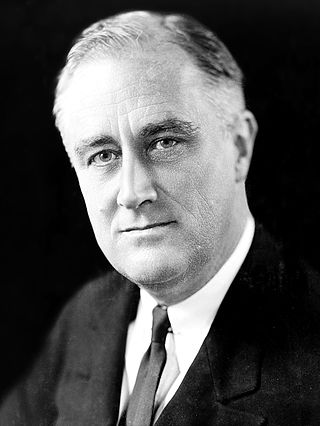
The 1932 United States presidential election was the 37th quadrennial presidential election, held on Tuesday, November 8, 1932. The election took place against the backdrop of the Great Depression. The incumbent Republican President Herbert Hoover was defeated in a landslide by Democrat Franklin D. Roosevelt, the governor of New York and the vice presidential nominee of the 1920 presidential election. Roosevelt was the first Democrat in 80 years to simultaneously win an outright majority of the electoral college and popular vote, a feat last accomplished by Franklin Pierce in 1852, as well as the first Democrat in 56 years to win a majority of the popular vote, which was last done by Samuel J. Tilden in 1876. Roosevelt was the last sitting governor to be elected president until Bill Clinton in 1992. Hoover became the first incumbent president to lose an election to another term since William Howard Taft in 1912, and the last to do so until Gerald Ford lost 44 years later. The election marked the effective end of the Fourth Party System, which had been dominated by Republicans. It was the first time since 1916 that a Democrat was elected president.

The 1948 United States elections were held on November 2, 1948. The election took place during the beginning stages of the Cold War. Democratic incumbent President Harry S. Truman was elected to a full term in an upset, defeating Republican nominee New York Governor Thomas E. Dewey and two erstwhile Democrats. The Democrats won back control of Congress from the Republicans. Until 2020, Democrats would never again flip a chamber of Congress in a presidential election cycle.

The 1876 United States elections were held on November 7. In one of the most disputed presidential elections in American history, Republican Governor Rutherford B. Hayes of Ohio ended up winning despite Democratic Governor Samuel J. Tilden of New York earning a majority of the popular vote. The Republicans maintained their Senate majority and cut into the Democratic majority in the House.

The 1944 United States elections was held on November 7, 1944, during the final stages of World War II. President Franklin D. Roosevelt was easily re-elected to an unprecedented fourth term, and the Democratic Party retained their majorities in both chambers of Congress.

The 1956 United States elections were held on Tuesday, November 6, 1956. Incumbent Republican President Dwight D. Eisenhower won reelection in a landslide, while the Democrats retained control of Congress.

The 1952 United States elections were held on November 4, 1952, during the Cold War and the Korean War. General of the Army Dwight D. Eisenhower won the White House in a landslide over Democratic Governor Adlai Stevenson of Illinois. Meanwhile, Republicans narrowly took control of both chambers of Congress, giving Republicans their first trifecta since the Great Depression. This is the last election until 2000 in which the Republicans held both chambers of Congress and the presidency at the same time. For the rest of the century, Republicans would often still win the presidency without full control of Congress.
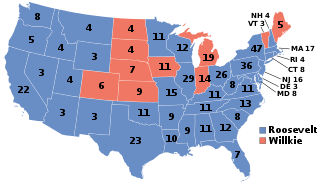
The 1940 United States elections was held on November 5. The Democratic Party continued to dominate national politics, as it defended its congressional majorities and retained the presidency. It was the last election prior to the attack on Pearl Harbor and America's entry into World War II.

The 1936 United States elections were held on November 3, 1936, during the Great Depression. Democratic President Franklin D. Roosevelt trounced Governor Alf Landon of Kansas in a landslide and the Democrats built on their majorities in both chambers of Congress.
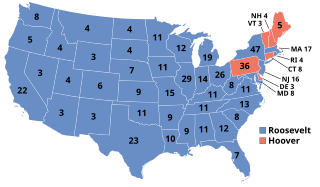
The 1932 United States elections were held on November 8, during the Great Depression. The presidential election coincided with U.S. Senate, U.S. House, and gubernatorial elections in several states. The election marked the end of the Fourth Party System and the start of the Fifth Party System. The election is widely considered to be a realigning election, and the newly established Democratic New Deal coalition experienced much more success than their predecessors had in the Fourth Party System.

The 1924 United States elections were held on November 4. The Republican Party retained control of the presidency and both chambers of Congress.

The 1916 United States elections elected the members of the 65th United States Congress. The election occurred during the Fourth Party System, six months before the United States entered World War I. Unlike 1912, the Democrats did not benefit from a split in the Republican Party, but the Democrats still retained the Presidency and the majority in the Senate. Democrats lost the majority in the House, but retained control of the chamber.
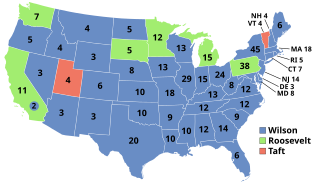
The 1912 United States elections elected the members of the 63rd United States Congress, occurring during the Fourth Party System. Amidst a division between incumbent Republican President William Howard Taft and former Republican President Theodore Roosevelt, the Democratic Party won the presidency and both chambers of Congress, the first time they accomplished that feat since the 1892 elections.

The 1908 United States elections elected the members of the 61st United States Congress, occurring during the Fourth Party System. Oklahoma joined the union during the 61st Congress. Despite the Panic of 1907, Republicans continued to control the presidency and both houses of Congress.

The 1904 United States elections elected the members of the 59th United States Congress. It occurred during the Fourth Party System. Republicans maintained control of the presidency and both houses of Congress. For the first time since the 1828 election, no third party or independent won a seat in Congress.

The 1884 United States elections were held on November 4, electing the members of the 49th United States Congress. The election took place during the Third Party System. The Democratic Governor Grover Cleveland of New York defeated Republican Secretary of State James G. Blaine in the presidential election. In Congress, the Republicans retained control of the Senate while Democrats maintained control of the House of Representatives. This marks the last election in U.S. history in which the Democratic president came to office without unified control of Congress.
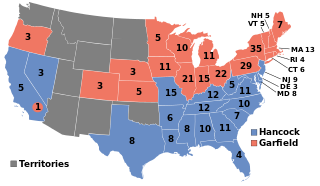
The 1880 United States elections occurred during the Third Party System, and elected the members of the 47th United States Congress. Republicans retained the presidency and took control of the House. An unclear partisan situation prevailed in the Senate. As the first presidential election after the end of Reconstruction, this election saw the first occurrence of the Democratic Party sweeping the Southern United States; the party would carry an overwhelming majority of Southern states well into the 20th century.
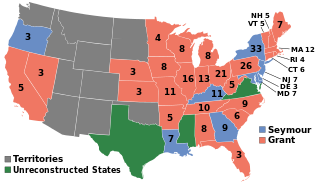
The 1868 United States elections was held on November 3, electing the members of the 41st United States Congress. The election took place during the Reconstruction Era, and many Southerners were barred from voting. However, Congress's various Reconstruction Acts required southern states to allow Black men to vote, and their voting power was significant to the elections results.

The 1856 United States elections elected the members of the 35th United States Congress and the President to serve from 1857 until 1861. The elections took place during a major national debate over slavery, with the issue of "Bleeding Kansas" taking center stage. Along with the 1854 elections, these elections occurred during the transitional period immediately preceding the Third Party System. Old party lines were broken; new party alignments along sectional lines were in the process of formation. The Republican Party absorbed the Northern anti-slavery representatives who had been elected in 1854 under the "Opposition Party" ticket as the second-most powerful party in Congress. Minnesota and Oregon joined the union before the next election, and elected their respective congressional delegations to the 35th Congress.

The 1852 United States elections elected the members of the 33rd United States Congress. The election marked the end of the Second Party System, as the Whig Party ceased to function as a national party following this election. Democrats won the presidency and retained control of both houses of Congress.

The 1848 United States elections elected the members of the 31st United States Congress and the 12th president of the United States. The election took place during the Second Party System, nine months after the Treaty of Guadalupe Hidalgo ended the Mexican–American War. With the issue of slavery dividing the nation, the Free Soil Party established itself as the third most powerful party in Congress. California joined the union before the next election, and elected its first Congressional delegation to the 31st Congress. Whigs won the presidency, but Democrats won a plurality in the House and retained control of the Senate.























